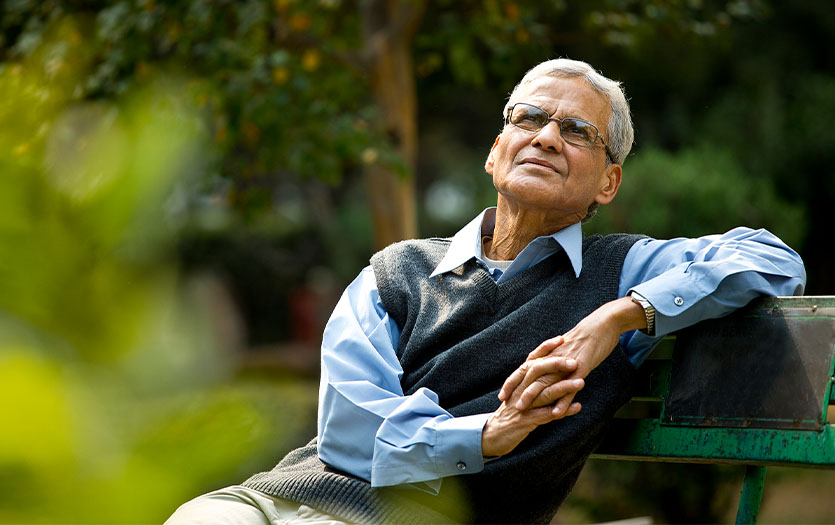.jpg)
Enjoy this monthly mindfulness post from Dave Johnson, PhD, CNS-BC, LMFT, employee assistance specialist.
At the turn of the century, I recall Bill Gates of Microsoft describing his vision for how the IT infrastructure could be likened to the nervous system of humans. Gates popularized this idea of a digital nervous system in his 1999 book, “Business @ the Speed of Thought”. I was driving home from Indianapolis listening to an interview with him when he noted that in the new millennium humans would be able to communicate at the speed of thought. That ideas, inventions and system improvements would accelerate in our businesses. He imagined a world of highly effective teams embracing this technology.
As a nurse, therapist and human scientist, I pondered the metaphor of a digital nervous system. Gates obviously had a vision for texting, tweeting, and digital devices that would soon engulf a new generation of workers and families. And although the changes of our workplaces and homes have benefitted greatly with this imagination and digital explosion, indeed the human nervous system has been impacted as well, and not always in a positive manner. Work days no longer end at 5 p.m. and work weeks often extend well into weekends. Families and friends spend more time on screens and digital devices then looking across a table into the eyes of a loved one. Tweets of anger and impulsive thoughts are exchanged between individuals and whole cultures. An e-blast in a moment of distress can wreak havoc, fear, anxiety, anger and destructive responses.
On an individual level, anxiety and stress disorders have become the most common of all illnesses and medications to treat them, some of the most highly prescribed drugs in America. Anxiety is considered a normal response to a realistic threat or danger and quickly resolves when the situation passes. When the anxiety response is out of proportion to the situation or chronically interferes with work, home or social functioning, individuals often seek assistance. The categories of anxiety disorders are broad and the human nervous system a bit complex. Neurotransmitters and brain centers are primitive and easily activated during the stress response. Heart rates and breathing accelerate, blood pressure climbs, feelings such as fatigue or being on edge emerge, difficulty concentrating, irritability, muscle tension, and sleep disturbances along with many somatic or bodily complaints gain the attention of family health practitioners who scramble to identify resources to help individuals and families cope.
There are several programs available at Parkview’s Center for Healthy Living, to help individuals and family cope with the epidemic of anxiety and stress responses. Many folks who attend our Mindfulness Based Stress Reduction (MBSR) and Mindfulness Self Compassion (MSC) courses express feelings of fear and anxiety related to death, betrayal, traumas, abuse, sickness, loneliness, shame, confusion, loss, or just the sheer overload of self and other expectations of home and work life. Balance is a desired state but exhaustion or near exhaustion is often the driving force to accessing our programming.
Using Mr. Gates’ metaphor of the digital nervous system with a twist might spawn some mindful ideas of rebooting anxiety and stress. I know when my computer gets “overloaded” and “stuck” often I use the keyboard keys of alt, control, delete, and end-task to reboot the system. Mindfulness works in this way as well. And so I ponder:
- Alternatives. Often good problem solving is needed to resolve anxiety and stress issues. Often the vortex of not having choices or enough time to problem solve is the issue at hand. The brain ruminates and goes over and over trying to problem solve and come up with alternatives. This vicious loop of thinking, and overthinking can interfere with our sleep and concentration and impacts our emotional well-being. If this is the case for you read on.
- Control. It also seems reasonable to think through what areas are causing stress and anxiety in one’s life and take control or let go. Sometimes anxiety is about our preoccupation with trying to impact a situation that we might not have any control over. For example, we’d like our spouse to be a bit more understanding or kind. We have cajoled, confronted and sought assistance from family, friends, minister, or therapy but perhaps our spouse is unwilling or unable to meet our needs. Letting go of our expectations is perhaps not a great option, but letting go of our marriage could add stress, anxiety, and a whole new chapter of additional stressors. Perhaps imagining what we really do have control over might be helpful? Read on.
- Delete. OK certainly this is doable. What is something taking my time and energy that I could let go to have a bit more time for self-care? Sure, I can let go of dirty dishes for an evening or two or let myself off the hook for my messy car. But suddenly my life begins to mirror confusion and chaos. Are there other things you would like to delete? For example, perhaps a sense of perfectionism, self-doubt, shame, guilt, old anger or hurt would be good to drop. Gosh, is that possible? Well, yes! The antidote to some of these thoughts and emotions is mindfulness meditation and self-compassion. But the nourishing of these practices is dose dependent meaning one doesn’t delete or get rid of these simply. The practice of mindfulness is an intentional, attentional, non-judgmental, compassionate way of being. Knowing what one should do and actually doing it is not the same thing. Practicing mindfulness can help.
- End-task. Do you like to make lists of all the things you need to do and cross them off once you accomplish them? Be honest, doesn’t it feel great to get things done? But our task lists are long, never ending, and often daunting. The pause button of mindfulness is perhaps a good option as well. Building our capacity to focus and noticing what is needed in a more nonreactive response can certainly help. I am pretty sure the task list will always be there and coming to a different relationship with our emotions and thoughts is equally needed.
- Reframe. Instead of saying, “I am anxious,” which heightens my strong identification with anxiety, perhaps it might be helpful to begin to have a default mode with the practice of learning to inhabit awareness. Just like noticing when it is raining outside, one can come to a better relationship by noticing one’s emotions and recognizing that they are not the content of their emotional response.
- Seek Resources. Mindfulness Based Stress Reduction programs promote a sense of balance and health promotion. Finding resources to nurture and build this skill can be helpful. The Parkview Center for Healthy Living has several intensive and introductory programs. One such program is the Word Project conducted by Kathy Curtis, Healing Artist. Kathy works with patients to name something that inspires them to move into a healing place. Consider finding a soothing moment of pause when you are a bit less emotionally charged. Consider gazing into this word “Anxiety” as a way of emphasizing that this is an emotion. Work on building awareness, listen to it tenderly, and perhaps explore how and where it is expressing itself in any moment somewhere in your body or thoughts. Seeing a bit more clearly what is actually going on and befriending it with its coming and going might seem a bit hokey, but the transformation of non-reactivity can have life-affirming attributes to one’s health and spirit.
Imam Ali was once quoted as saying, “A moment of patience in a moment of anger can help us avoid a thousand moments of sorrow.”
Mindfulness-based stress reduction practice has been extensively researched and proven helpful for coping with stress and change, grief, healthy eating patterns, pain, anxiety, depression and many other chronic disease and autoimmune disorders. For a free 1:1 in person or telephonic consultation with Dr. Dave or to find out about more on Mindfulness & Stress Management programs, contact the Parkview Center for Healthy Living at (260) 672-6500. Dr. Johnson also provides on-site guidance for teambuilding and transformational leadership, among other topics. To learn more about Employees Assistance Programs for your company, call Business Development at (260) 373-9013.
Other resources:
InvisibleInklings.com - Sign up for free monthly word-based mindful healing exercises from Dr. Dave and Kathy Curtis.



